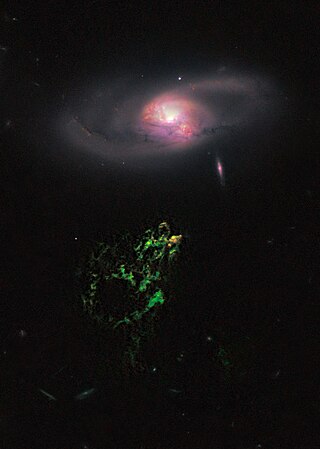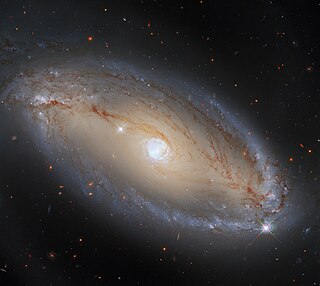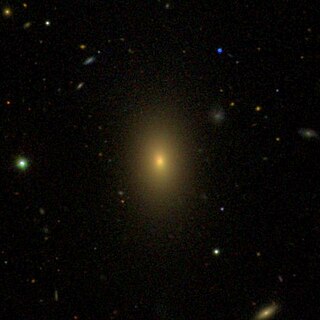
A quasar is an extremely luminous active galactic nucleus (AGN). It is sometimes known as a quasi-stellar object, abbreviated QSO. The emission from an AGN is powered by a supermassive black hole with a mass ranging from millions to tens of billions of solar masses, surrounded by a gaseous accretion disc. Gas in the disc falling towards the black hole heats up and releases energy in the form of electromagnetic radiation. The radiant energy of quasars is enormous; the most powerful quasars have luminosities thousands of times greater than that of a galaxy such as the Milky Way. Quasars are usually categorized as a subclass of the more general category of AGN. The redshifts of quasars are of cosmological origin.
An active galactic nucleus (AGN) is a compact region at the center of a galaxy that emits a significant amount of energy across the electromagnetic spectrum, with characteristics indicating that this luminosity is not produced by the stars. Such excess, non-stellar emissions have been observed in the radio, microwave, infrared, optical, ultra-violet, X-ray and gamma ray wavebands. A galaxy hosting an AGN is called an active galaxy. The non-stellar radiation from an AGN is theorized to result from the accretion of matter by a supermassive black hole at the center of its host galaxy.

3C 273 is a quasar located at the center of a giant elliptical galaxy in the constellation of Virgo. It was the first quasar ever to be identified and is the visually brightest quasar in the sky as seen from Earth, with an apparent visual magnitude of 12.9. The derived distance to this object is 749 megaparsecs. The mass of its central supermassive black hole is approximately 886 million times the mass of the Sun.

Galaxy Zoo is a crowdsourced astronomy project which invites people to assist in the morphological classification of large numbers of galaxies. It is an example of citizen science as it enlists the help of members of the public to help in scientific research.

Hanny's Voorwerp is a type of astronomical object called a quasar ionization echo. It was discovered in 2007 by Dutch schoolteacher Hanny van Arkel while she was participating as a volunteer in the Galaxy Zoo project, part of the Zooniverse group of citizen science websites. Photographically, it appears as a bright blob close to spiral galaxy IC 2497 in the constellation Leo Minor.

A Pea galaxy, also referred to as a Pea or Green Pea, might be a type of luminous blue compact galaxy that is undergoing very high rates of star formation. Pea galaxies are so-named because of their small size and greenish appearance in the images taken by the Sloan Digital Sky Survey (SDSS).
SDSS J1254+0846 is a face-on binary quasar pair which is in the process of merging. This binary quasar is the first resolved luminous pair to be observed in the act of merging. The pair is composed of two luminous radio-quiet quasars located at redshift z=0.44, being SDSS J125455.09+084653.9 and SDSS J125454.87+084652.1, or SDSS J1254+0846 collectively. These designations also refer to their host galaxies. This pair provide evidence for the theory that quasars are switched on by galactic collisions. The pair are optically separated by 3.6 arcseconds, giving the real separation as 21 kpc. Tidal tails some 75 kpc have been detected around the galaxies. Thus the two galaxies involved are disc galaxies. The pair was first detected by the Sloan Digital Sky Survey, hence the "SDSS" designations. The tidal tails were first observed by the Magellan Telescopes. A computer simulation by Thomas Cox of the Carnegie Institute corroborated the hypothesis that these were two merging galaxies. This binary quasar, was at the time of discovery in 2010, the lowest redshift binary quasar then observed.

Green bean galaxies (GBGs) are very rare astronomical objects that are thought to be quasar ionization echos. They were discovered by Mischa Schirmer and colleagues R. Diaz, K. Holhjem, N.A. Levenson, and C. Winge. The authors report the discovery of a sample of Seyfert-2 galaxies with ultra-luminous galaxy-wide narrow-line regions (NLRs) at redshifts z=0.2-0.6.

Pierre Cox is a French astronomer. Born in Paris to a Dutch composer father and a Belgian pianist mother, he led a musically-oriented childhood from which he rebelled at age 17 to study physics at the Université de Paris-Sud. He is known for his research in the area of millimeter and infrared observations of star-forming regions, evolved stars, and high-redshift galaxies. He has published over 250 refereed papers with more than 22,000 citations in total. Cox is currently a Director of Research (DR1) at CNRS, working at the Institut d'Astrophysique de Paris. From 2013 - 2018, Cox was the Director of ALMA, a position requiring coordinating the efforts of many countries that Cox likened to "being the Secretary General of United Nations". He was previously the Director of the Institut de radioastronomie millimétrique from 2006 through 2013. Prior to IRAM, he had been an astronomer at the Max Planck Institute for Radio Astronomy, the Marseille Observatory, and then the Institut d’Astrophysique Spatiale, an observatory of the CNRS at the Université de Paris-Sud in Orsay. Pierre's hobbies including drawing and playing piano. He speaks five languages fluently.

NGC 3862 is an elliptical galaxy located 300 million light-years away in the constellation Leo. Discovered by astronomer William Herschel on April 27, 1785, NGC 3862 is an outlying member of the Leo Cluster.

NGC 6814 is an intermediate spiral galaxy in constellation Aquila. It is located at a distance of about 75 million light years from Earth, which, given its apparent dimensions, means that NGC 6814 is about 85,000 light years across. NGC 6814 has an extremely bright nucleus and is a type 1.5 Seyfert galaxy. The galaxy is also a highly variable source of X-ray radiation. The ultraviolet and optical emission also varies, although more smoothly, with time lag of two days. The cause of the lag and the smoothing of light curves is considered to be the reprocessing of the X-rays in the accretion disk. The cause of the active galactic nucleus is suspected to be a supermassive black hole with a mass about 18 million times that of the Sun. Many regions of ionised gas are studded along the dusty spiral arms.

NGC 708 is an elliptical galaxy located 240 million light-years away in the constellation Andromeda and was discovered by astronomer William Herschel on September 21, 1786. It is classified as a cD galaxy and is the brightest member of Abell 262. NGC 708 is a weak FR I radio galaxy and is also classified as a type 2 Seyfert galaxy.

NGC 4636 is an elliptical galaxy located in the constellation Virgo. It is a member of the NGC 4753 Group of galaxies, which is a member of the Virgo II Groups, a series of galaxies and galaxy clusters strung out from the southern edge of the Virgo Supercluster. It is located at a distance of about 55 million light years from Earth, which, given its apparent dimensions, means that NGC 4636 is about 105,000 light years across.

NGC 5846 is an elliptical galaxy located in the constellation Virgo. It is located at a distance of circa 90 million light years from Earth, which, given its apparent dimensions, means that NGC 5846 is about 110,000 light years across. It was discovered by William Herschel on February 24, 1786. It lies near 110 Virginis and is part of the Herschel 400 Catalogue. It is a member of the NGC 5846 Group of galaxies, itself one of the Virgo III Groups strung out to the east of the Virgo Supercluster of galaxies.

NGC 5728 is an active barred spiral galaxy located 146 million light years away in the southern constellation of Libra. It was discovered on May 7, 1787 by William Herschel. The designation comes from the New General Catalogue of J. L. E. Dreyer, published in 1888. It has an apparent visual magnitude of 13.40 and spans an angle of 3.4 arcminutes. The galaxy shows a red shift of 0.00935 and has a heliocentric radial velocity of 2,803 km/s. It has an estimated mass of 72 billion times the mass of the Sun and stretches around 30 kpc across.

An extended emission-line region (EELR) is a giant interstellar cloud ionized by the radiation of an active galactic nucleus (AGN) inside a galaxy or photons produced by the shocks associated with the radio jets. An EELR can appear as a resolved cloud in relative nearby galaxies and as narrow emission lines in more distant galaxies.

NGC 3758 known as the Owl Galaxy, is a type Sb spiral galaxy in the constellation of Leo. It is located 447 million light-years from the Solar System and an approximate diameter of 70,000 light-years. NGC 3758 was discovered by Ralph Copeland on March 18, 1874, but also independently discovered by Edouard Stephan ten years later.

4C +09.17 is a quasar located in the constellation Orion. With a redshift of 2.108300, the object is located 10.6 billion light years from Earth and presents an extragalactic astrophysical jet morphology.

PG 1543+489, also known as QSO B1544+4855 and PGC 2325245, is a quasar located in the constellation of Boötes. At the redshift of 0.399, the object is located 4.5 billion light-years away from Earth. It was first discovered in 1983, by researchers who presented 114 objects in the Palomar-Green bright quasar survey, as one of the best studied samples of active galactic nuclei (AGN).

NGC 4325 is an elliptical galaxy located about 330 million light-years away in the constellation Virgo. It was discovered by astronomer Heinrich d'Arrest on April 15, 1865, who described it as "vF, vS, iR, nf of 2". Despite being listed in the Virgo Cluster catalog as VCC 616, it is not a member of the Virgo Cluster but instead a background galaxy.



















